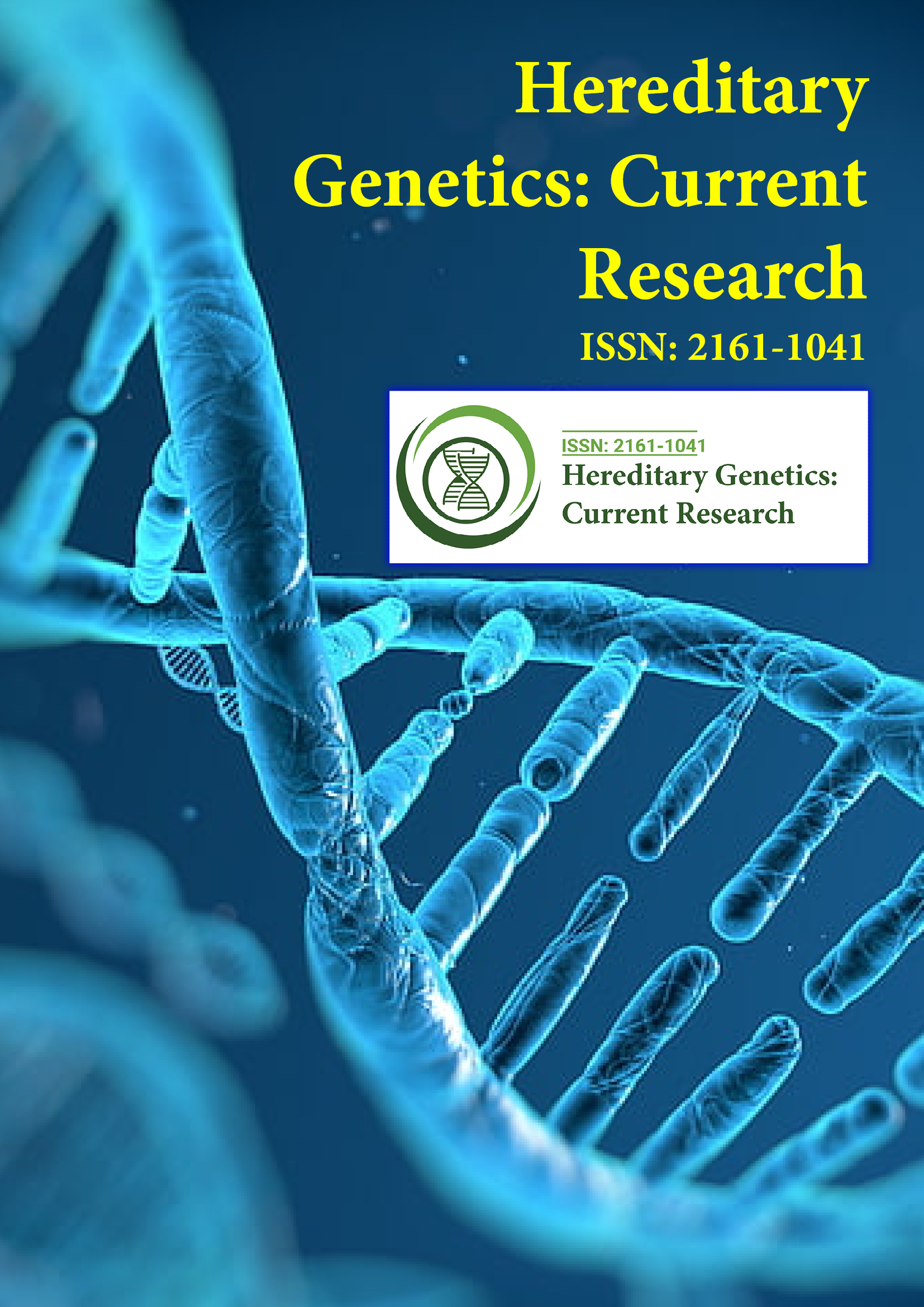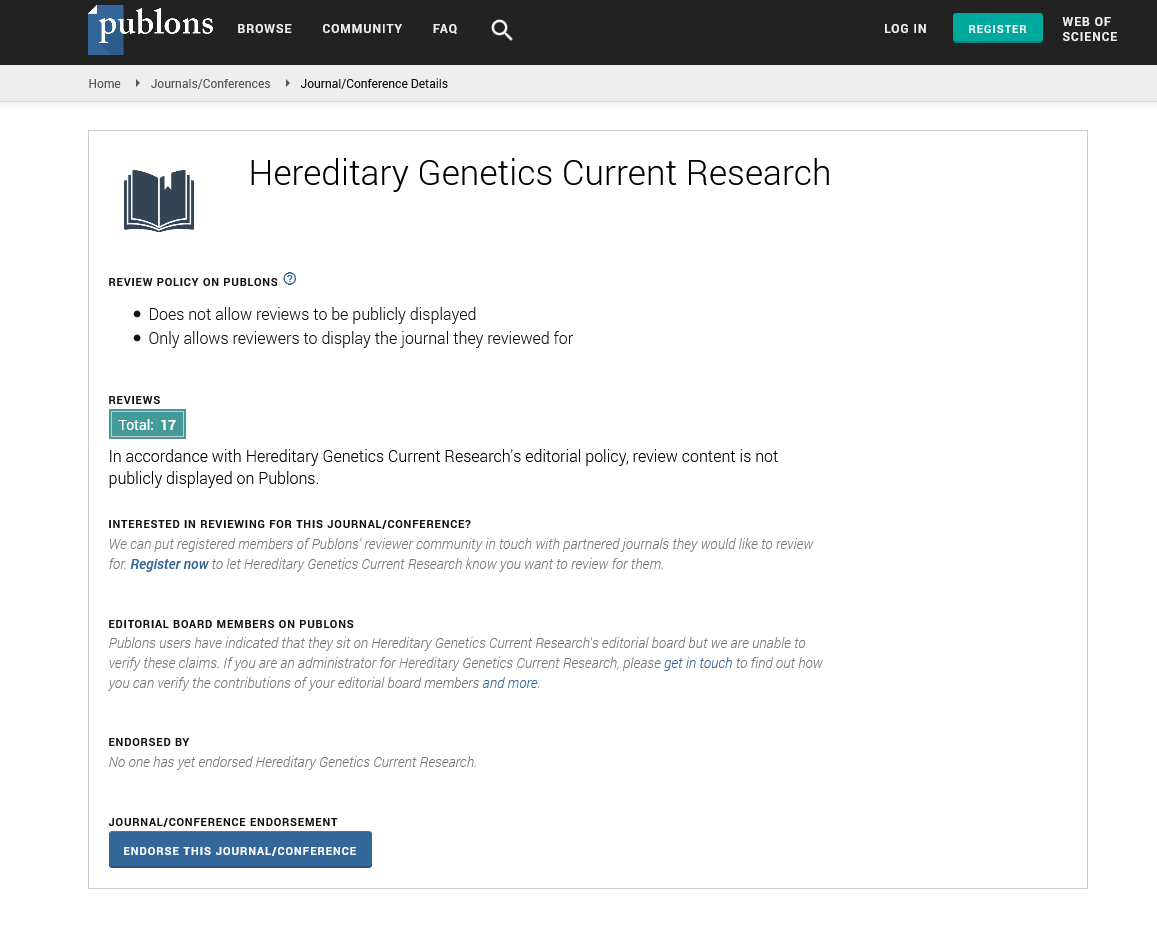Indexed In
- Open J Gate
- Genamics JournalSeek
- CiteFactor
- RefSeek
- Hamdard University
- EBSCO A-Z
- NSD - Norwegian Centre for Research Data
- OCLC- WorldCat
- Publons
- Geneva Foundation for Medical Education and Research
- Euro Pub
- Google Scholar
Useful Links
Share This Page
Journal Flyer

Open Access Journals
- Agri and Aquaculture
- Biochemistry
- Bioinformatics & Systems Biology
- Business & Management
- Chemistry
- Clinical Sciences
- Engineering
- Food & Nutrition
- General Science
- Genetics & Molecular Biology
- Immunology & Microbiology
- Medical Sciences
- Neuroscience & Psychology
- Nursing & Health Care
- Pharmaceutical Sciences
Perspective - (2024) Volume 13, Issue 4
Hereditary Retinoblastoma: Genetic Insights and Emerging Therapy
Laura Fischer*Received: 29-Nov-2024, Manuscript No. HGCR-24-28206; Editor assigned: 02-Dec-2024, Pre QC No. HGCR-24-28206 (PQ); Reviewed: 16-Dec-2024, QC No. HGCR-24-28206; Revised: 23-Dec-2024, Manuscript No. HGCR-24-28206 (R); Published: 30-Dec-2024, DOI: 10.35248/2161-1041.24.13.295
Description
Hereditary retinoblastoma is a rare pediatric cancer of the retina, primarily caused by germline mutations in the RB1 gene. As one of the most well-characterized hereditary cancer syndromes, it serves as a model for understanding the molecular mechanisms of tumorigenesis and the inheritance of cancer predisposition. The RB1 gene, located on chromosome 13q14, encodes the Retinoblastoma Protein (pRB), a tumor suppressor that plays a significant role in regulating the cell cycle. pRB controls the transition from the G1 phase to the S phase by inhibiting the activity of E2F transcription factors. Loss or inactivation of both alleles of the RB1 gene leads to unchecked cellular proliferation, a characteristic of cancer.
Hereditary retinoblastoma arises when individuals inherit a germline mutation in one copy of the RB1 gene, predisposing retinal cells to malignant transformation. This "first hit" is present in every cell of the body, following Knudson’s "two-hit hypothesis." The second hit, often caused by somatic mutations, occurs in retinal progenitor cells and factors tumor development. Approximately 40% of retinoblastoma cases are hereditary, while the remaining 60% are sporadic, arising from biallelic somatic mutations in RB1. Hereditary cases are typically bilateral (affecting both eyes) or multifocal, whereas sporadic cases tend to be unilateral and unifocal. Early onset of disease and a positive family history are characteristics of hereditary retinoblastoma.
Advances in molecular genetics have identified diverse mutations in the RB1 gene associated with hereditary retinoblastoma, including point mutations, insertions, deletions and large chromosomal rearrangements. Next-Generation Sequencing (NGS) and Multiplex Ligation-Dependent Probe Amplification (MLPA) have revolutionized the detection of these mutations, improving diagnostic accuracy and enabling personalized management strategies. Collaborative efforts by institutions such as Harvard Medical School and the Broad Institute have been instrumental in cataloging RB1 mutations and their functional consequences. In addition to RB1, recent studies have uncovered the involvement of epigenetic alterations and modifier genes in hereditary retinoblastoma. Methylation of the RB1 promoter region and loss of imprinting have been implicated in silencing the wild-type allele, while polymorphisms in genes regulating apoptosis and DNA repair may influence disease penetrance and progression.
The identification of a germline RB1 mutation has significant implications for patients and their families. Genetic counseling is a foundation of hereditary retinoblastoma care, providing atrisk individuals with information on inheritance patterns, cancer risks and surveillance options. Prenatal testing and Preimplantation Genetic Diagnosis (PGD) are increasingly available for families with known mutations, enabling informed reproductive choices.
Clinical management of hereditary retinoblastoma emphasizes early detection and treatment to preserve vision and prevent metastasis. Surveillance protocols include frequent eye examinations under anesthesia during infancy and childhood, as well as imaging modalities such as ultrasonography and Magnetic Resonance Imaging (MRI). Advances in imaging technology, spearheaded by researchers at the University of Toronto and the Mayo Clinic, have enhanced the early detection of retinal tumors and associated abnormalities.
Therapeutic approaches for hereditary retinoblastoma depend on the extent and location of the disease. Enucleation, or removal of the affected eye, remains a definitive treatment for advanced unilateral tumors. However, recent decades have seen significant progress in globe-sparing therapies, including systemic and intra-arterial chemotherapy, focal laser therapy and cryotherapy. Comprehensive approaches combining these treatments have achieved high rates of tumor control while minimizing the need for enucleation. Patients with hereditary retinoblastoma are at increased risk of developing second primary malignancies, particularly osteosarcoma, soft tissue sarcomas and melanoma, due to the systemic nature of the germline RB1 mutation.
In conclusion, the genetics of hereditary retinoblastoma exemplify the complex exchange between molecular biology, clinical care and family-centered management. Advances in genetic testing and molecular diagnostics have transformed our understanding of the disease, enabling early detection and personalized therapeutic approaches. As research into genetic modifiers, epigenetic regulation and targeted therapies continues to evolve, the future holds potential for further improving outcomes for patients with hereditary retinoblastoma and their families. Collaborative efforts across global research institutions are essential to address the remaining challenges and to unlock new opportunities for innovation in the diagnosis and treatment of this pediatric cancer.
Citation: Fischer L (2024). Hereditary Retinoblastoma: Genetic Insights and Emerging Therapy. Hereditary Genet. 13:295.
Copyright: © 2024 Fischer L. This is an open access article distributed under the terms of the Creative Commons Attribution License, which permits unrestricted use, distribution, and reproduction in any medium, provided the original author and source are credited.

